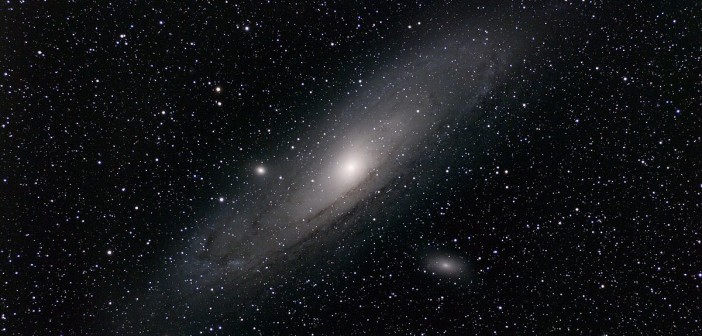How do ultra-compact dwarf galaxies (UCDs) — galaxies that are especially small and dense — form and evolve? Scientists have recently examined distant galaxy clusters, searching for more UCDs to help us answer this question.
Origins of Dwarfs
In recent years we have discovered a growing sample of small, very dense galaxies. Galaxies that are tens to hundreds of light-years across, with masses between a million and a billion solar masses, fall into category of “ultra-compact dwarfs”.

An example of an unresolved compact object from the authors’ survey that is likely an ultra-compact dwarf galaxy. [Adapted from Zhang & Bell 2017]
- An initially larger galaxy was tidally stripped during interactions with other galaxies in a cluster, leaving behind only its small, dense core as a UCD.
- UCDs formed as compact galaxies at very early cosmic times. The ones living in a massive dark matter halo may have been able to remain compact over time, evolving into the objects we see today.
To better understand which of these formation scenarios applies to which galaxies, we need a larger sample size! Our census of UCDs is fairly limited — and because they are small and dim, most of the ones we’ve discovered are in the nearby universe. To build a good sample, we need to find UCDs at higher redshifts as well.
A New Sample
In a recent study, two scientists from University of Michigan have demonstrated how we might find more UCDs. Yuanyuan Zhang (also affiliated with Fermilab) and Eric Bell used the Cluster Lensing and Supernova Survey with Hubble (CLASH) to search 17 galaxy clusters at intermediate redshifts of 0.2 < z < 0.6, looking for unresolved objects that might be UCDs.

The mass and size distributions of the UCD candidates reported in this study, in the context of previously known nuclear star clusters, globular clusters (GCs), UCDs, compact elliptical galaxies (cEs), and dwarf galaxies. [Zhang & Bell 2017]
The properties of this new set of UCD candidates aren’t enough to distinguish between formation scenarios yet, but the authors argue that if we find more such galaxies, we will be able to use the statistics of their spatial and color distributions to determine how they were formed.
Zhang and Bell estimate that the 17 CLASH clusters studied in this work each contain an average of 2.7 of these objects in the central million light-years of the cluster. The authors’ work here suggests that searching wide-field survey data for similar discoveries is a plausible way to increase our sample of UCDs. This will allow us to statistically characterize these dense, compact galaxies and better understand their origins.
Citation
Yuanyuan Zhang and Eric F. Bell 2017 ApJL 835 L2. doi:10.3847/2041-8213/835/1/L2


2 Comments
Pingback: ultra compact dwarf galaxies formation problem
Pingback: Nuove galassie nane ultracompatte | Accademia delle Stelle